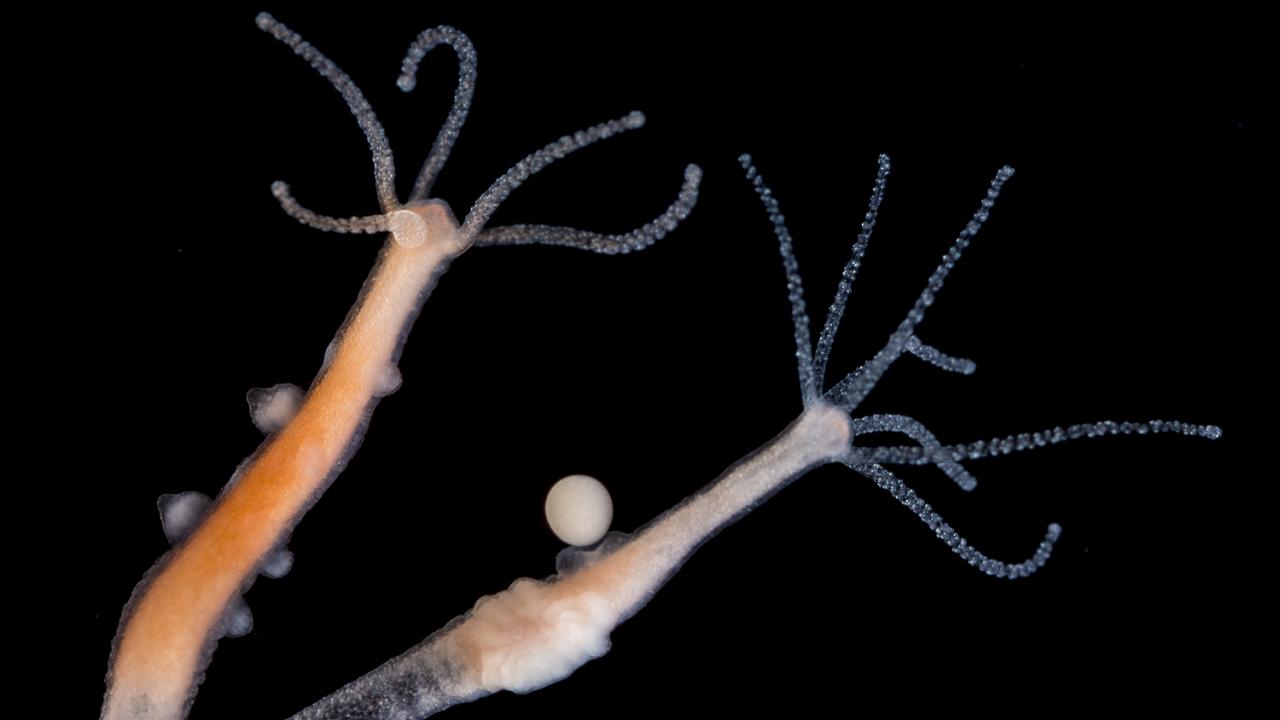
$1 Million Keck Foundation Grant Backs Research to "Build a Brain"
Manipulating the nervous system of Hydra vulgaris
A team of scientists from UC Davis and Rice University are starting small as they begin to figure out how to build an artificial brain from the bottom up.
Celina Juliano, an associate professor in the Department of Molecular and Cellular Biology, and Jacob Robinson of Rice University’s Brown School of Engineering have won a $1 million Keck Foundation grant to advance the team’s synthetic neurobiology effort to define the connections between neurons and muscles that drive programmed behaviors in living animals.
To begin with, Robinson, Juliano and their colleagues are putting their faith in a very small animal, the freshwater cnidarian Hydra vulgaris, a tiny tentacled creature that has long been a focus of study in the Robinson and Juliano labs. In 2019, Juliano and her UC Davis colleagues published a study in Science that documented their use of single-cell sequencing techniques to create a “single-cell molecular map” of nearly all of the cell types in Hydra, which yielded an unexpected application in neuroscience.
“We found that the Hydra’s nervous system is very simple,” said Juliano. “And knowing the genes that are expressed, and where the neurons are, gives us what are essentially molecular handles we can use to drive the expression of exogenous genes, even to manipulate the nervous system.”
The value, in this case, is the potential to break existing connections and create new ones, which could be used to engineer new behaviors. “To successfully engineer new neural connections, we first have to know how the animal itself works,” explained Juliano. “That’s what initially excited a biologist like me.” Now, with a sophisticated understanding of this simple organism, Juliano and Robinson are ready to build on existing understandings of neurobiology.
Combined with the Juliano lab’s cell type-specific genetic manipulation techniques, Robinson’s team, part of Rice’s Neuroengineering Initiative, hopes its high-throughput neural and behavioral recording technologies will allow the researchers to improve their understanding of how neural pathways regulate Hydra behavior.
“We’ve built a lot of the infrastructure to work with the animals in the lab to measure their neural activity and their behaviors,” Robinson said. “We also use computational techniques to automate the process, which allows us to look at many animals in parallel and get large quantities of data.
“The next big leap will be to edit the animal’s nervous systems, and that’s what this award will help support,” he said. “For example, if we want to create a synthetic connection between two neurons, we could make specific neurons in the animal express a neuropeptide signaling molecule. We could then engineer another group of neurons, or even the muscle cells, to express the receptor for that signaling molecule.
“Then we’ll have made a new organism with a connection between two cells that don’t normally connect,” he said. “In principal, we can build on this concept to make more complicated networks and designer neural circuits. As an engineer, I like to think of these connections between neurons like electronic circuits. If we can wire them up by design we should be able to program behaviors from scratch.”
Because Hydra reproduce both sexually and asexually, the labs expect they’ll be able to create colonies of custom Hydra for analysis.
Robinson ultimately hopes to design and build soft, self-healing “biorobots,” as well as to create and repair organs and tissues that require functioning neural circuitry, in this case, “designer circuits” like biological oscillators, switches and logic gates that will “enable rational design of complex behaviors.”
The W. M. Keck Foundation was established in 1954 in Los Angeles by William Myron Keck, founder of The Superior Oil Co. One of the nation’s largest philanthropic organizations, the foundation supports outstanding science, engineering and medical research. The foundation also supports undergraduate education and maintains a program within Southern California to support arts and culture, education, health and community service projects.
Media Resources
- This story was originally posted by Rice University
